
Jewish cemeteries of Warsaw refers to a number of Jewish necropolises in the city.

Jewish cemeteries of Warsaw refers to a number of Jewish necropolises in the city.

Okopowa Street Jewish Cemetery is one of the largest Jewish cemeteries in Europe. Located on Okopowa Street and abutting the Powązki Cemetery, the Jewish Cemetery was established in 1806 and occupies 33 hectares (83 acres) of land. [1]
It is now the site of numerous overgrown and abandoned graves and crypts, having fallen in disrepair after the Nazi invasion of Poland and subsequent Holocaust. Although it was closed down during World War II, after the war it was reopened and a small portion of it remains active, serving Warsaw's small remaining Jewish population.
Bródno Jewish Cemetery was once much bigger than the earlier cemetery and served both the Jews of the right-bank borough of Praga and poorer Jews of other boroughs of the city of Warsaw. [2] After the Okopowa Street cemetery became overcrowded, the Praga cemetery was intended as the main Jewish cemetery. However, after the German occupation of Poland in 1939 and the start of the Holocaust, most of it was demolished and the headstones were used as street pavement. After the war the remaining tombstones were recovered from various towns in Poland and moved back to the cemetery. Currently it is inactive and serves as a monument only.
Nowa Jerozolima (New Jerusalem) Cemetery was a cemetery of one of the numerous Jewish villages founded in the area of the Polish capital in the 17th and 18th centuries. It was closed down in late 18th century and the village itself was incorporated into Warsaw to become the namesake of Aleje Jerozolimskie, one of Warsaw's principal streets. [3] In early 19th century, during the Austrian occupation of Warsaw, the cemetery was closed down and the ashes were moved to cemetery in Powązki.
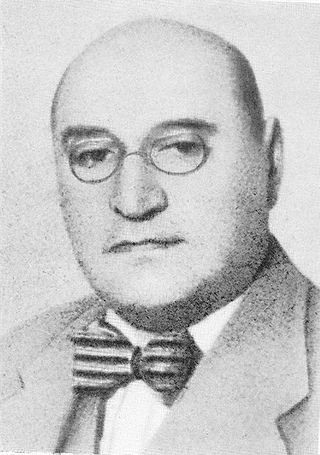
Adam Czerniaków was a Polish engineer and senator who was head of the Warsaw Ghetto Jewish Council (Judenrat) during World War II. He committed suicide on 23 July 1942 by swallowing a cyanide pill, a day after the commencement of mass extermination of Jews known as the Grossaktion Warsaw.

Praga is a district of Warsaw, Poland. It is on the east bank of the river Vistula. First mentioned in 1432, until 1791 it formed a separate town with its own city charter.
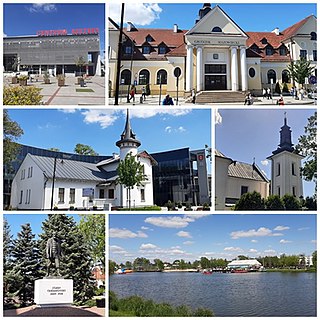
Grodzisk Mazowiecki is a town in central Poland, the capital of Grodzisk Mazowiecki County in the Masovian Voivodeship, with 29,363 inhabitants (2011). It is 30 kilometres (19 mi) southwest of Warsaw.
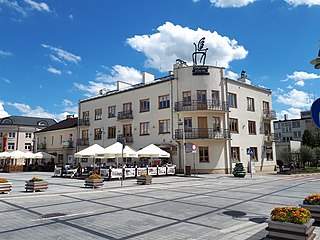
Piaseczno is a town in east-central Poland with 47,660 inhabitants. It is situated in the Masovian Voivodeship, within the Warsaw metropolitan area, just south of Warsaw, approximately 16 kilometres south of its center. It is a residential area and a suburb of Warsaw. It is the capital city of Piaseczno County.

Leżajsk, officially the Free Royal City of Leżajsk, is a town in southeastern Poland with 13,871 inhabitants. It has been situated in the Subcarpathian Voivodeship since 1999 and is the capital of Leżajsk County.

Gęsiówka is the colloquial Polish name for a prison that once existed on Gęsia ("Goose") Street in Warsaw, Poland, and which, under German occupation during World War II, became a Nazi concentration camp.

Olyka is a rural settlement in Lutsk Raion, Volyn Oblast, western Ukraine. It is located east of Lutsk on the Putylivka Rriver. Its population is 3,032.
Following the establishment of the Second Polish Republic after World War I and during the interwar period, the number of Jews in the country grew rapidly. According to the Polish national census of 1921, there were 2,845,364 Jews living in the Second Polish Republic; by late 1938 that number had grown by over 16 percent, to approximately 3,310,000, mainly through migration from Ukraine and the Soviet Russia. The average rate of permanent settlement was about 30,000 per annum. At the same time, every year around 100,000 Jews were passing through Poland in unofficial emigration overseas. Between the end of the Polish–Soviet War of 1919 and late 1938, the Jewish population of the Republic grew by nearly half a million, or over 464,000 persons. Jews preferred to live in the relatively-tolerant Poland rather than in the Soviet Union and continued to integrate, marry into Polish Gentile families, to bring them into their community through marriage, feel Polish and form an important part of Polish society. Between 1933 and 1938, around 25,000 German Jews fled Nazi Germany to sanctuary in Poland.

The Warsaw Jewish Cemetery is one of the largest Jewish cemeteries in Europe and in the world. Located on Warsaw's Okopowa Street and abutting the Christian Powązki Cemetery, the Jewish necropolis was established in 1806 and occupies 33 hectares of land. The cemetery contains over 250,000 marked graves, as well as mass graves of victims of the Warsaw Ghetto. Although the cemetery was closed down during World War II, after the war it was reopened and a small portion of it remains active, serving Warsaw's existing Jewish population.

Szymon Datner was a Polish historian, Holocaust survivor and underground operative from Białystok, who was born in Kraków and died in Warsaw. He is best known for his studies of the Nazi war crimes and events of The Holocaust in the Białystok region. His 1946 Walka i zagłada białostockiego ghetta was one of the first studies of the Białystok Ghetto.
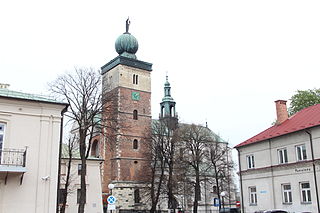
Miechów is a town in Poland, in Lesser Poland Voivodeship, about 40 kilometres north of Kraków. It is the capital of Miechów County. Population is 11,852 (2004). Miechów lies on the Miechówka river, along European route E77. The area of the town is 15 square kilometres (6 sq mi), and it has a rail station, located on the main railroad which connects Kraków with Warsaw.
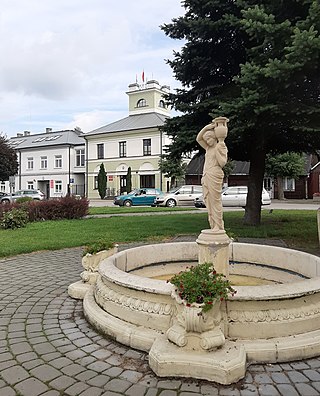
Mogielnica is a town in Grójec County in Masovian Voivodeship, Poland, with 2,475 inhabitants (2004) and an area of 141.56 square kilometres. It is the seat of Gmina Mogielnica.
The history of Warsaw spans over 1400 years. In that time, the city evolved from a cluster of villages to the capital of a major European power, the Polish–Lithuanian Commonwealth—and, under the patronage of its kings, a center of enlightenment and otherwise unknown tolerance. Fortified settlements founded in the 9th century form the core of the city, in today's Warsaw Old Town.

Radzanów is a village in Mława County, Masovian Voivodeship, in east-central Poland, approximately 28 kilometres (17 mi) south-west of Mława and 101 km (63 mi) north-west of Warsaw. It is the seat of the gmina called Gmina Radzanów.
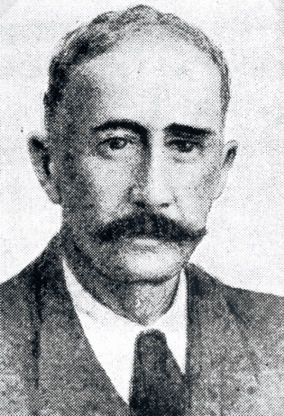
Leon Feiner was a Polish lawyer and activist. He was an activist of the General Jewish Labour Bund in Poland and between November 1944 and January 1945 the director (prezes) and vice-chairman of the Council to Aid Jews "Żegota".

Abraham Blum was a Polish-Jewish socialist activist, one of the leaders of the Bund in the Warsaw Ghetto and a participant in the Warsaw Ghetto Uprising.

The Warsaw Ghetto boundary markers are memorial plaques and boundary lines that mark the maximum perimeter of the former ghetto established by Nazi Germany in 1940 in occupied Warsaw, Poland.

Młynów is a neighbourhood of the western borough of Wola in Warsaw, the capital of Poland.

Bródno Jewish Cemetery is one of several Jewish cemeteries of Warsaw in Poland. The cemetery is located in the district of Targówek. The cemetery has been founded in 1780. It occupies an area of 5 hectares.